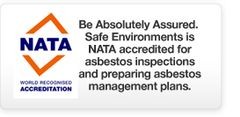Hazardous Materials Inspections & Management Plans
Hazardous Building Materials may be found within buildings that pose a significant risk to health to occupants. Hazardous materials include:
- Asbestos Containing Materials (ACM)
- Synthetic Mineral Fibres (SMF)
- Polychlorinated Biphenyl’s (PCB)
- Lead Paint
- Ozone Depleting Substances
Safe Environments is a Type A inspection body accredited by NATA (accreditation No: 17139) and complies with the requirements of AS/NZS ISO.IEC 17020 (2000) for the inspection of hazardous materials (HazMat) including asbestos.
Safe Environments Hazardous Materials (HazMat) inspection reports are produced in accordance with the requirements of the National Occupational Health and Safety Commission Code of Practice for the Management and Control of Asbestos in Workplaces [NOHSC:2018(2005)].
Safe Environments undertake 3 types of hazardous materials inspections accredited by NATA which include:
- Type 1 – Location and assessment hazardous materials inspections (Presumptive HazMat Inspections)
- Type 2 – Location and assessment hazardous materials inspections (Sampling HazMat Inspections)
- Type 3 – Full access sampling and identification hazardous materials inspections (pre demolition/major refurbishment Hazmat Inspections)
Type 1 & 2 HazMat inspections are for management of hazardous materials during normal occupation whereas Type 3 HazMat inspections are for demolitions and major refurbishments which are generally required for council requirements.
Hazardous Materials Management Inspections & Surveys
Hazardous Materials management inspections and surveys are conducted by a qualified HazMat consultant who will walk through and identify as far as reasonably practicable, materials that are likely to contain hazardous materials. The hazardous materials are listed within an hazardous materials register which include a risk assessment, location and representative photos. Hazardous Materials (HazMat)inspections & surveys include:
Not all suspected materials will contain asbestos. Depending on the type or building, age and construction, there commonly is between 40 – 80 % of samples containing asbestos. While sampling inspections are more expensive initially due to the expense of asbestos testing, sampling asbestos inspections are more cost effective in the long term as those materials which do not contain asbestos can be treated as not being a risk, saving money in maintenance, repair and eventual demolition which can incur significant expense.
Hazardous Materials Refurbishment and Demolition Inspections & Surveys
Refurbishment and demolition HazMat inspections & surveys are carried out to identify and remove hazardous materials to eliminate the risk of exposure to workers and the surrounding environment. Refurbishment and demolition HazMat inspections are required even when Management Inspections have been carried out. Refurbishment and demolition Hazardous Materials inspections will also inspect within the building fabric to find hidden materials within wall cavities and the like. This involves partial destruction of the finishes whilst the building is not occupied, prior to the actual demolition or refurbishment.
Hazardous Materials Management Plans
A hazardous materials management plan clearly identifies the roles and responsibilities of an organisation to reduce the potential for related health effects to hazardous materials. An HazMat management plan involves a systematic process to:
- Identify hazardous materials
- Assess the risk of hazardous materials
- Control the risk of exposure to hazardous materials
Ongoing Hazardous Materials Management
Formal HazMat management plans are then required to cleanly identify the roles and responsibilities within the organisation and will generally include:
- Organisational responsibilities
- Health effects of hazardous materials
- Minimum legislative requirements
- Priority risk assessments
- Maintenance
- Removal
- Labeling
- Training
- Clearance certificates
- Emergency procedures
- Regular HazMat inspections
- Review of the management process


